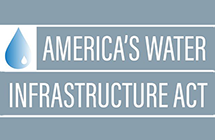 |
 |
|
| eNews • November 2018 | ||
| Promoting a Cost-Effective, Reliable and Competitive Transportation System |
||
 Letter To The Editor: Water Infrastructure Act
Letter To The Editor: Water Infrastructure Act
On Tuesday, October 23, President Trump signed into law the "America's Water Infrastructure Act of 2018" (S.3021). Title I of the act included the Water Resources Development Act (WRDA) of 2018. On October 10, the Senate passed the legislation by a vote of 99-1. The House of Representatives passed the legislation unanimously on September 13.
There are two steps the federal government will take as it endeavors to maintain and improve the nation's inland waterway system. The first step is the authorization process, which the passage of a WRDA bill achieves. WRDA legislation essentially establishes a blueprint or strategy. It identifies the priority projects-the "to do" list for the nation's inland waterway system. The second step is the appropriations process, in which funding is directed toward the projects identified in the WRDA legislation.
I will be the first to acknowledge that the inland waterway issue-particularly regarding the condition of our nation's locks and dams-can often sound like a broken record. Numerous stakeholders have labored for years to advocate for the system. Unfortunately, previous congresses and administrations have failed to respond appropriately to this pressing need. The inland waterway system continues to be undercapitalized, and numerous lock and dam sites continue to degrade. A failure at one or more sites is not outside the realm of possibility.
That being said, there have been a number of victories over the past number of years. The barge industry, agriculture, and other stakeholders are to be credited for these successes. Congress has resumed passing a WRDA bill every two years in 2014, 2016 and now again in 2018. Prior to 2014, the most recent WRDA bill passed into law was in 2007. The more time that elapses between the passage of one WRDA bill and another, the more difficult it becomes to get Congress to devote the necessary time and energy to address the needs of the inland waterway system. Many members of Congress do not represent regions adjacent to navigable waterways so they have a lack of understanding and appreciation for the significant contribution of waterways to the U.S. economy. It therefore requires a sizable education effort to convince Congress to act on these important issues. Getting back onto a two-year cycle for passing a WRDA bill allows the positive momentum on this issue to continue. Congressional leaders, particularly Chairman Bill Shuster (R-Pa.) and Ranking Member Peter DeFazio (D-Ore.) deserve particular credit for this.
In addition to getting back to a two-year cycle for WRDA legislation, Congress has appropriated additional funding to address the sizable needs of the system. Below are the most recent appropriation levels from Congress for the Army Corps of Engineers' Civil Works program - the program that oversees the maintenance and improvement of our lock and dam inventory:
Between 2013 to the present, Congress has provided a 48 percent increase in funding for the civil works portfolio.
As mentioned above, the remaining needs of the inland waterway system are significant. Stakeholders, including the Soy Transportation Coalition, will continue to promote maintaining and improving this critical link in our logistics chain. The soybean industry and agriculture are confronted with some sobering challenges at the moment. It is therefore critical to make sure our supply chain helps facilitate our profitability and is not an obstacle to it.
Source: Waterways Journal
Soy Transportation Coalition |
|
